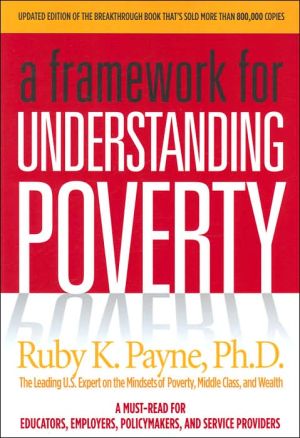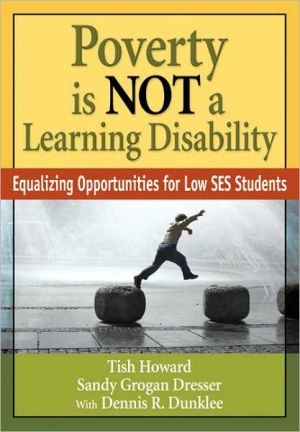Understanding and Managing Emotional and Behavior Disorders in the Classroom
Comprehensive and current, this new text will prepare future educators to successfully instruct students with emotional and behavior disorders in their classrooms. Readers will be given a sound introduction on the subject, from the foundations of the disorders, to a discussion of risk and protective factors, and also a general bio-psychosocial model. The whole text will stimulate its readers to think about the behavior problems and issues they might address in the real classroom and how to...
Search in google:
Comprehensive and current, this new text will prepare future educators to successfully instruct students with emotional and behavior disorders in their classrooms. Readers will be given a sound introduction on the subject, from the foundations of the disorders, to a discussion of risk and protective factors, and also a general bio-psychosocial model. Several, particularly hard-to-manage disorders are featured in multiple chapters, and assessment is briefly addressed, including comparing Functional Behavior Assessment with regular assessment, the Behavior Intervention Plans, and Individual Education Plans. Behavior problems manifested and managed in the classroom is reviewed, with an emphasis on the development of positive behavioral interventions and supports. Also discussed are specific behavior interventions for problematic behavior, focusing on how such students are best taught, and how a positive school-wide program enhances the probability of program success. Families and siblings, along with promising future directions are also included, as well as thought-provoking case studies featured throughout the text. Special features of the text include: Overview and Discussion Questions at the beginning of every chapter, and a Summary and follow-up Discussion Questions at the conclusion, boxed features found throughout each chapter to clarify and further describe important content, including law-related issues, and thought-provoking case studies are dispersed throughout. The whole text will stimulate its readers to think about the behavior problems and issues they might address in the real classroom and how to best deal with each situation.
Chapter 1 Classification and the Physiological ApproachClassification Systems of Autism Spectrum DisordersPrevalanceWhat Causes Autism Spectrum Disorders?Physiological InterventionsWorking in Collaboration with SpecialistsChapter 2 AssessmentScreening InstrumentsDiagnostic ProcessesAssessments for Educational Planning and InterventionCurriculum-Based Assessment and Monitoring ProgressChapter 3 Identifying Evidence-Based Educational PracticesWhy Implement Educational Strategies?When Should Intervention Begin?What Does the Law State About When, Who, Where, What and How?Evolution of Education LegislationWho Participates on the Individual Education Plan/Individualized Family Services Plan Team?Where Should Instruction Take Place?What Should Be Taught?How Do We Teach Effectively Using Evidence-Based Practices?Evolution of Facilitated Communication: A Strategy Without Evidence of SupportChapter 4 Applied Behavior Analysis: Increasing SkillsTheoretical Basis for Applied Behavior AnalysisHistory of Applied Behavior Analysis and AutismEthical ApplicationsKey ConceptsOperational Target BehaviorsStrategies Based on Key ConceptsKey Concepts Put into PracticeResearch Support for PracticeChapter 5 Applied Behavior Analysis: Replacing BehaviorEvolution of Applied Behavior Analysis to Decrease BehaviorSelecting Socially Important BehaviorsReinforcementPunishmentMotivating OperationsStimulus-Response-Consequence or Antecedent-Behavior-ConsequenceObservation and MeasurementStrategies Based on Key ConceptsFunctional Analysis and AssessmentImplementation of Functional Assessments in Collaboration with FamiliesImplementation of Functional Assessments by EducatorsSelf-ManagementToken EconomicsCombinations of StrategiesKey Concepts Put into PracticeResearch Using Applied Behavior Analysis to Decrease and Replace BehaviorsChapter 6 Developmental and Social-Relational ApproachesTheoretical Basis for the Developmental and Social-Relational ApproahcesThe DIR/Floortime ApproachEvolution of the DIR/Floortime ApproachHistory of Responsive Teaching with Individuals with Autism Spectrum DisordersHistory of Relationship Development Intervention (rdi) with Individuals with Autism Spectrum DisordersHistory of the Denver Model with Individuals with Autism Spectrum DisordersPivotal Response Treatment with Individuals with Autism Spectrum DisordersHistory of SCERTS with Individuals with Autism Spectrum DisordersKey Concepts of the Developmental and Social-Relational Approaches Put Into PracticeResearch on the Developmental and Social-Relational ApproachesChapter 7 Cultural ApproachesTheoretical Basis for the TEACCH ApproachHistory of Structured TeachingKey ConceptsStrategies Based on Key ConceptsKey Concepts Put into PracticeResearch on Structured Teaching and the TEACCH ApproachWorking in Collaboration with Families from Diverse CulturesTeaching in a Manner That is Culturally ResponsiveEncouraging Identity Development as an Educational GoalResearch Support for Practice Focusing on CultureChapter 8 Focus on CommunicationTheories of Language DevelopmentUnderstanding Typical Communication DevelopmentCommunication Issues and Delays in AutismThe Importance of CommunicationEnhancing Educator Skills as Communication PartnersFocusing on Oral LanguageUsing Augmentation and Alternative Communication (ACC) SystemsAddressing Deficits in Nonverbal CommunicationFunctional Communication to Replace Challenging BehaviorStrategies to Teach Complex LanguageDesigning an Evidence-Based Classroom to Facilitate CommunicationChapter 9 Building Social Skills and Social RelationshipsTheories of Social DevelopmentUnderstanding Typical Social-Emotional DevelopmentSocial-Emotional Issues in Autism Spectrum DisordersEnhancing Educator Skills as Social PartnersAddressing Joint Attention and Social ReferencingFocus on PeersTeaching Educators to Use Guided Participation and Scaffolding During PlayAddressing Conversation SkillsAdditional Strategies Used to Increase Social Skills and Social InteractionCollaboration in the Work PlaceLove and Marriage?Issues and Research QuestionsChapter 10 Systems of Support and AccountabilityPersonnel ShortageThe Critical Elements for Effective TrainingImplementing Evidence-Based Practices for Individuals with Autism Spectrum DisordersCoaching, Mentoring, and Supervisory SupportImplementing a Systems ApproachSystem Accountability for Effective PracticeMaintaining and Sustaining Effective PracticeFamily Advocacy for Policy ChangeFamily Members as Key PartnersChallenges to the FamilyChallenges to the Family/Professional PartnershipRecommendations To and By Parents Regarding Evidence-Based PracticesCall for Optimism and Action in the Creation of Communities of Practice








